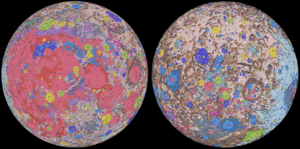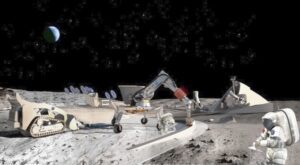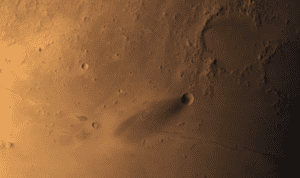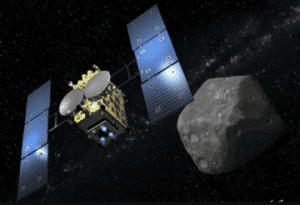By Christophe Bosquillon

In his 1963 masterpiece ‘Il Gattopardo’ (‘The Leopard’), Luchino Visconti, based on Giuseppe Tomasi di Lampedusa’s 1958 novel, narrates the tale of a Sicilian family during the 1860’s unification of Italy by Garibaldi’s army. Burt Lancaster stars as the aging Don Fabrizio Corbera, Prince of Salera, of a world decaying but not fully collapsed yet. Alain Delon acts as his nephew, Prince Tancredi Falconeri, grabbing the opportunity of a world that is emerging but hasn’t fully risen yet. Claudia Cardinale is his bride, Angelica Sedara, who navigates this historical change and resulting political and social upheaval with wit, elegance, and class. The film starts with Tancredi claiming that “everything has to change”, only to conclude the story with a sober acknowledgement that: “in the end, something had to change so that everything stays the same”. Fast forward to the early 2020s, here we are now, reaching out to space, returning to the Moon, this time to stay. While Earth remains engulfed by endless wars, biosphere destruction, and other calamities of biblical proportion, we too, not unlike Don Fabrizio, Tancredi, and Claudia, navigate upheaval again. For us too, this is not an era of change, but a change of era. In that context, we’d like to ask ourselves a simple question: “Will we, Earthlings, take the Moon as our second and indeed last chance, and not blow it this time around?”.
Will we, Earthlings, take the Moon as our second and indeed last chance, and not blow it this time around?
A question for all stakeholders, and that means the public too
What sounds like a philosophical and ethical question, is also of direct concern to policy and decision makers: several space exploration and resource utilization (SRU) priority decisions (Moon vs asteroids, elements/metals vs polar ice water, Mars as a goal, etc.) will have to be made, soon, that are central for everyone: from agencies to investors to operators, law and governance professionals, and last but not least, space diplomacy, defense, and security actors. Civil society, and the general public, might want to have a say as well: emerging countries and not merely dominant space-faring nations; women at large and not merely the nerdy techies “boys will be boys” club; and a large chunk of the younger generations, starting with Gen-Z: already laden with 20th century Earth geopolitics and ecosystem liabilities, they too earned their place at the table of many a multi-stakeholders forum.
If Moon water is the new oil, then what should we expect?
Let’s start with lunar polar ice, which is a strategic objective for several space agencies and therefore nation-states. Earth history shows that, wherever and whenever there are resources, territorial implications, and a form of market economy, conflict ensues. Will we have water wars in space? When we hear there’s a new space race and that in space (Moon) water is the new oil, we are reminded of General Pierre Marie Gallois’s book “Le Sang du Petrole” – Oil’s Blood – (written in the early 2000’s Middle East context, it would be equally relevant in a Donbas, Crimea, and surrounding contexts). On the Moon, water is necessary for life support systems, growing vegetables, or having animals. However, water is essential not only for life but also as a propellant for cislunar transportation. Industrial Moon water will be required in infrastructures on the Moon and in cislunar space. And albeit further reduction of launch costs off-Earth will push the economic viability of Moon water by years or decades to the right, the importance of Moon water for the cislunar economy will warrant that the water may strategically impact the viability of industrial value chains. In other words, water might be the limiting factor for the development of the Moon system and might be more important than minerals or whatever else we are searching for on the Moon.
The OST non-appropriation principle, the right of the utilization of what is extracted, and maybe the implementation of a non-fully exclusive workaround for ‘priority rights’, all might help regulate the future of Moon water usage. But, territorial appropriation is only a violation of international law. Would a central Moon port deconflict Moon water rivalry? Since logistics is used as a political strategy and war tactics embodied (Straits of Malacca and Hormuz, Suez Canal, the 1936 Montreux Convention, access to the Black Sea, controlling the port of Odesa, etc..) it could make things better, or worse. If nations-states stick to prioritizing Moon water, they need to manage it in secure and economical terms.
Could Earth shifting to renewable energy make the Moon a new “World Factory”?

As demonstrated during Space Resources Week 2022, components for ‘clean’ energy systems -from solar panels to fuel cells to wind turbines- are made from elements that derive from the ugliest mining pits and production sites on Earth. That also applies to all hi-tech components (phones, etc.). Since mine tailings are costly to process and manage, could the Moon become the new “World Factory”? The lunar surface offers silicates for solar panels, Platinum Group Metals (PGMs), and Rare Earth Elements (REEs) for hydrogen fuel cells and hi-tech components, together with several metals. Notwithstanding the speed at which Earth may exit from coal and oil (gas might stick around a bit longer), and provided that long touted Space-Based Solar Power systems can ever manifest in Earth orbit, there seems to be merit in delocalizing some industrial hi-tech production to the Moon. Granted, the Moon’s surface has archeological and legacy value, therefore that would require several heart-breaking trade-offs in how we practice environmental impact mitigation on the Moon. That would be performed with an architecture prioritizing Moon comms and NPT, autonomous systems/AI, and additive (3D) printing, to minimize the numbers of “biologically high maintenance” humans to be involved. Which doesn’t exactly look like Klondike. The purpose indeed looks less like human exploration and settlement glamour, and more like a sanitary rearrangement of the Earth-Moon ecosystem that delocalizes dirty industries out of Earth. We would then argue that the caution exercised in Moon water affairs should similarly be applied when it comes to extracting and utilizing the Moon’s mineral resources, to be managed equally in security and economic terms.
Does Mars matter after all?

Yes and no. For ‘yes’, everyone has their idea on the topic and some act on it. For ‘no’, Mars is not a business case- yet. Terraforming isn’t going to happen in time to save the Earth from the ongoing quasi-catastrophic “engrenages” (clockwork, meaning spiral) currently eating its fingers and soon the whole arm. So, Mars will be self-funded by governments, the private sector, and individuals for a while. And while it may create some demand for Moon activities, it’s not going to generate a foundation for a sustainable Solar System economy any time soon. In the following centuries, perhaps, provided Earth remains livable. And, to the risk of disappointing many, we’re not a big fan of Moon Helium-3 as a priority, simply because fusion technology is not achievable in the foreseeable future. But it matters for R&D.
Do asteroids make sense?
Again, yes and no. For ‘yes’, an infinite supply of elements on Near Earth Asteroids/Objects, and on the Belt beyond Mars (and you need to speak Creole according to ‘The Expanse’) would be useful to the Earth-Moon ecosystem. Hayabusa 1 and 2 have successfully demonstrated a proof of concept to drill a Near Earth Asteroid/Object and bring back the material. For ‘no’, the techno-economics of mining several ‘Near’ asteroids aren’t there yet. By convention, a Solar System body is a Near Earth Object if its closest approach to the Sun (perihelion) is less than 1.3 “a.u.”, which is about 150 million kilometers, or 93 million miles. This means that every time a ship carrying material or components between relevant facilities has to cross even a tenth of an “a.u.”, that still means 15 million kilometers or 9 million miles.
In comparison, the Moon, at only 0.38 million km (0.23 million miles) from Earth, is in no-nonsense proximity to mine and industrialize first. This said we would not fully de-prioritize asteroids in the supply side of useful elements. Besides iron and nickel, PGMs such as platinum, iridium, and palladium make sense. They are a useful business case to evaluate, in the triangular economics of Earth, Moon, and asteroids, operating at scale. We’ll probably understand better how the two parameters of demand drivers and value chain economics pan out for the asteroid supply side, once we have a clearer picture of how the same parameters work for the Moon: the lunar resources supply as part of an integration between Earth economy and Moon manufacturing facilities.

On the other hand, cislunar transportation will remain stuck in a chemical propellant pattern for a while, whereas the cargo-to-propellant ratio of 1 to 12-15 can make or break the economics of a value chain. So, we need to work on asteroids following a well-understood order of priority based on the experiences on the Moon. Asteroids could also have a role in space-made infrastructures on the way to Mars, pending breakthroughs in new space propulsion modes. The point is, that all the above statements need to be qualified by rigorously quantified studies as we implement logistics and industrialization for the Moon, rather than by just mere claims. Creating digital twins of Earth + Moon + Asteroids and running machine-learning-driven simulations might help guide policies.
Governance and sustainability-minded space investing have gone mainstream
We were recently invited to pitch a couple of asset classes to a group of family offices, with an agenda focusing on areas such as digital transformation and new space, together with a strong ESG ethos. The official program language stated something along the lines of “how can we, the 1%, use our privileged position to expand economy, knowledge, and social outcomes, through more productive philanthropy”. This, together with the early June 2022 Financial Times Investing in Space conference, on which we have reported, signals that governance and sustainability-minded space investing has gone mainstream. Good news for the Moon, yet, meanwhile, on Earth, access and benefit sharing start with capacity building among nations and communities, not merely the dominant economies and space powers. All these issues more than ever need to be part and parcel of multi-stakeholders for planetary conversations.
If only we exchanged, discussed, and communicated our visions better
As more multi-stakeholders fora emerge, however, how we use language, data and media, will make a huge difference in the shaping of the space exploration and SRU mindset, as it does for things like history, democracy, or war. What if an experienced businessperson, not as tired as a Don Fabrizio, and still as opportunistic and ambitious as a Tancredi, would tell you that, indeed, profits are great, but humanity is by far much greater. And, if, where there is no vision, the people perish (Proverbs), then, we’d like to add that vision without funding is hallucination (a friend coined that). Indeed, we should support those who work tirelessly to create new communication tools that can communicate a vision, a new ethic, and a new inclusive philosophy of space exploration, that starts from humanity rather than profit. It certainly is a long game, that kind of vision is clearly long-term, and it’s going to be a long fight.

Currently based in Europe, Christophe Bosquillon operated globally out of the Indo-Pacific for the best part of the past decades. With a techno-economic background in non-space industries, as well as international affairs and foreign direct investment, Chris maintains a long-standing interest in old and new space, also from a security and policy standpoint. A decade ago, he developed a ‘Legal Hacker’ interest in the digital transformation governance field, data rights, computational law, and composable governance. Founder of Autonomous Space Futures Ltd., Chris, an experienced corporate boss and business owner, focuses on solutions to develop business cases in and beyond orbit: value propositions TRL-realistic over time, commercially credible, financially sustainable, legally implementable ; optimizing open data and registration in a context of adaptive governance for peaceful and sustainable space activities. While fixing the investee-investors relationship, value creation, and funding processes, Chris currently works out on the steep learning curve of space law, governance, and diplomacy.





